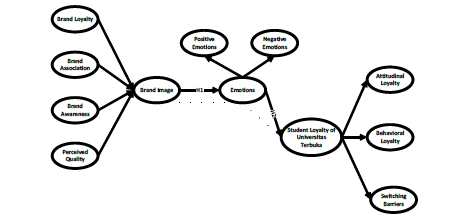Brand Image, Emotions, and Student Loyalty of Universitas Terbuka Indonesia
Keywords:
Brand Image, loyalty, purposive sampling, SEM, Universitas TerbukaAbstract
This article explores the concept of brand image and its significance in consumer behavior and marketing strategies in the context of Universitas Terbuka Indonesia. Brand image is defined as the perception of a brand in the minds of consumers, shaped by experiences, marketing communications, and interactions with the brand. The study examines the components that contribute to a strong brand image of Universitas Terbuka, including brand identity, consistency, and emotional connection. Through a review of relevant literature and case studies, the article highlights how a positive brand image of Universitas Terbuka can enhance student loyalty, differentiate products in competitive markets of education industry, and drive overall business performance. Additionally, the research addresses the challenges brands face in maintaining a favorable image of Universitas Terbuka in the digital age, where people opinions can spread rapidly through social media. The sample size in this study is 471 which dispersed to three big cities (Jakarta, Bandung, Surabaya) in Indonesia. The sampling technique is purposive. By the supporting of IBM SPSS AMOS, data analysis was conducted with Structural Equation Modeling (SEM) in this study. The findings underscore the need for brands to engage authentically with their audience and adapt to changing perceptions to sustain their image in a dynamic marketplace
References
Aaker, J. L. (1997). Dimensions of brand personality. Journal of Marketing Research, 34(3), 347-356.
Aaker, D. A. (1996). Building Strong Brands. Free Press.
Aaker, D. A., & Jacobson, R. (2001). "The Financial Value of Brands." Harvard Business Review, 79(1), 138-145.
Aaker, D. A., Kumar, V., & Day, G. S. (2013). Marketing Research (11th ed.). Wiley.
Alharbi, A. & Drew, S. (2014). "The Role of Brand Image in Building Loyalty for Educational Institutions." International Journal of Educational Management, 28(5), 505-520.
Alves, H., & Raposo, M. (2007). The Influence of Students' Perception of the University on Their Loyalty. International Journal of Educational Management, 21(3), 223-232.
Astin, A. W. (1993). Higher Education: Social Change and the Role of Students.
Astin, A. W. (1999). Student Involvement: A Developmental Theory for Higher Education. Journal of College Student Development.
Baker, M. J., & Ballington, K. (2002). Brand Management. European Journal of Marketing, 36(3-4), 277-290.
Baker, M. J., & Hart, S. (2008). The Marketing Book. Butterworth-Heinemann.
Bennett, R. (2006). The Importance of Brand Image in the Education Sector. International Journal of Educational Management, 20(5), 368-377.
Bennett, R., & Rundle-Thiele, S. (2005). The Brand Loyalty Life Cycle: A Study of Brand Image, Brand Loyalty, and the Mediating Role of Emotions. Journal of Marketing Management, 21(3-4), 197-213.
Bridger, E. (2008). Branding the University: Developing and Maintaining a Strong University Brand. Journal of Higher Education Policy and Management, 30(4), 349-359.
Chaudhuri, A., & Holbrook, M. B. (2001). "The Chain of Effects from Brand Trust and Brand Affect to Brand Performance: The Role of Brand Loyalty." Journal of Marketing, 65(2), 81-93.
Chen, C. F., & Tsai, M. T. (2007). The Impact of Brand Experience on Brand Loyalty: The Mediating Role of Brand Satisfaction and Brand Trust. Journal of Brand Management, 14(5), 276-290.
Chin, W. W. (1995). "The Partial Least Squares Approach to Structural Equation Modeling." In Modern Methods for Business Research (pp. 295-336). Lawrence Erlbaum Associates.
Cova, B. (1997). Community and Consumption: Towards a definition of the ‘linking value’ of a brand. In Advances in Consumer Research, 24, 322-327.
Dick, A. S., & Basu, K. (1994). "Customer Loyalty: Toward an Integrated Conceptual Framework." Journal of the Academy of Marketing Science, 22(2), 99-113.
Duncan, T., & Moriarty, S. (1998). A Communication-Based Marketing Model for Managing Relationships. Journal of Marketing, 62(2), 1-13.
Fischer, K. (2009). Emotions in Education. The Cambridge Handbook of the Learning Sciences. Cambridge University Press.
Fischer, S. (2016). Emotional Branding in Higher Education: The Role of Emotions in Student Choice. Journal of Marketing for Higher Education, 26(1), 71-88.
Fornell, C., & Larcker, D. F. (1981). "Evaluating Structural Equation Models with Unobservable Variables and Measurement Error." Journal of Marketing Research, 18(1), 39-50.
Fournier, S. (1998). Consumers and Their Brands: Developing Relationship Theory in Consumer Research. Journal of Consumer Research, 24(4), 343-373.
González, J. A., & GarcíA, D. J. (2018). The Impact of Brand Image on Customer Loyalty: A Study in the Higher Education Sector. Education and Information Technologies, 23(5), 2291-2310.
Gummesson, E. (1999). Total Relationship Marketing. Butterworth-Heinemann.
Hair, J. F., Anderson, R. E., Tatham, R. L., & Black, W. C. (2014). Multivariate Data Analysis (7th ed.). Pearson.
Hemsley-Brown, B. S. H., & Oplatka, I. (2015). *University Choice: The Role of Emotions*. Journal of Marketing for Higher Education.
Hu, L. T., & Bentler, P. M. (1999). "Cutoff Criteria for Fit Indexes in Covariance Structure Analysis: Conventional Criteria Versus New Alternatives." Structural Equation Modeling, 6(1), 1-55.
Huang, Y., & Sarigöllü, E. (2014). "The Impact of Brand Experience on Brand Loyalty: The Mediating Role of Brand Satisfaction and Brand Trust." Journal of Brand Management, 21(8), 747-762.
Hulland, J., Chow, G., & Lam, S. S. K. (1996). "Use of Structured Frameworks to Develop and Test a Model of Brand Equity." Journal of Brand Management, 4(3), 185-199.
Kapferer, J. N. (2008). The New Strategic Brand Management: Advanced Insights and Strategic Thinking. Kogan Page.
Keller, K. L. (2003). Strategic Brand Management: Building, Measuring, and Managing Brand Equity. Pearson Education.
Kolb, D. A. (1984). *Experiential Learning: Experience as the Source of Learning and Development*. Prentice Hall.
Kocak, A. & Arditi, D. (2009).** "Brand Loyalty in Higher Education: An Examination of the Antecedents." *Journal of Marketing for Higher Education*, 19(1), 23-44.
Kumar, V., & Reinartz, W. (2016). Creating Enduring Customer Value. Journal of Marketing, 80(6), 36-68.
Madhavaram, S., & Hunt, S. D. (2008). A Conceptual Model of Brand Commitment: An Extension of Brand Loyalty. Journal of Brand Management, 16(1), 41-57.
Mazzarol, T., & Soutar, G. N. (2002). “Push-pull" Factors Influencing International Student Destination Choice. International Journal of Educational Management, 16(2), 82-90.
Meyer, J. P. & Allen, N. J. (1991). A Three-Component Conceptualization of Organizational Commitment. Human Resource Management Review, 1(1), 61-89.
McGinnis, P. M. (2016). *The Role of Emotions in Academic Success: A Study of Student Engagement*. Journal of Educational Psychology.
McCarthy, H. J. (2019). *Emotional Intelligence and Student Loyalty: A Path to Retention*. International Journal of Educational Management.
Oliver, R. L. (1999). "Whence Customer Loyalty?" Journal of Marketing, 63(Special Issue), 33-44.
Park, C. W., & MacInnis, D. J. (2006). What’s in and what’s out: Questions on the boundaries of the brand concept. Journal of Business Research, 59(5), 686-693.
Patterson, P. G., & Smith, S. (2003). Modeling Relationships Among Brand Image, Student Satisfaction, and Student Loyalty. Journal of Marketing for Higher Education, 12(1), 25-48.
Pritchard, M. P., & Wilson, G. (2003). Using Student Satisfaction Data to Improve Student Retention. Journal of College Student Retention: Research, Theory & Practice, 4(3), 199-214.
Ramsay, J. (2015). Building Student Loyalty: The Role of Brand Image and Student Experience. Higher Education Research & Development, 34(3), 483-498.
Rovai, A. P. (2003). In Search of Higher Ground: A Comparative Analysis of the Sense of Community and Satisfaction of Students in Two Different Educational Settings. International Journal of Learning, 10(5), 32-39.
Sargeant, A., & Jay, E. (2004). Building Customer Relationships: A Strategic Approach. Journal of Marketing Management, 20(3-4), 413-431.
Suh, A. & Lee, H. (2017). "The Impact of Brand Image on Student Loyalty in Higher Education: The Mediating Role of Student Satisfaction." International Journal of Educational Management, 31(4), 467-484.
Tinto, V. (1993). *Leaving College: Rethinking the Causes and Cures of Student Attrition*. University of Chicago Press.
Watson, D., & Tellegen, A. (1988). "Developing Measures of Positive and Negative Affect: The PANAS Scales." Journal of Personality and Social Psychology, 54(6), 1063-1070.
Wheaton, G. F., Muthén, B. O., Alwin, D. F., & Summers, G. F. (1995). "Assessing Reliability and Stability in Panel Models." In Sociological Methodology (pp. 84-136).
Yoo, B., & Donthu, N. (2001). Developing a Scale to Measure External Brand Equity. Journal of Marketing Research, 38(2), 198-211.

Downloads
Published
How to Cite
Conference Proceedings Volume
Section
License
Copyright (c) 2024 Shine Pintor Siolemba Patiro, Usman Mika’il Usman, Kabul Wahyu Utomo, Endi Rekarti, Faizul Mubarok, Joko Rizkie Widokarti

This work is licensed under a Creative Commons Attribution-ShareAlike 4.0 International License.











